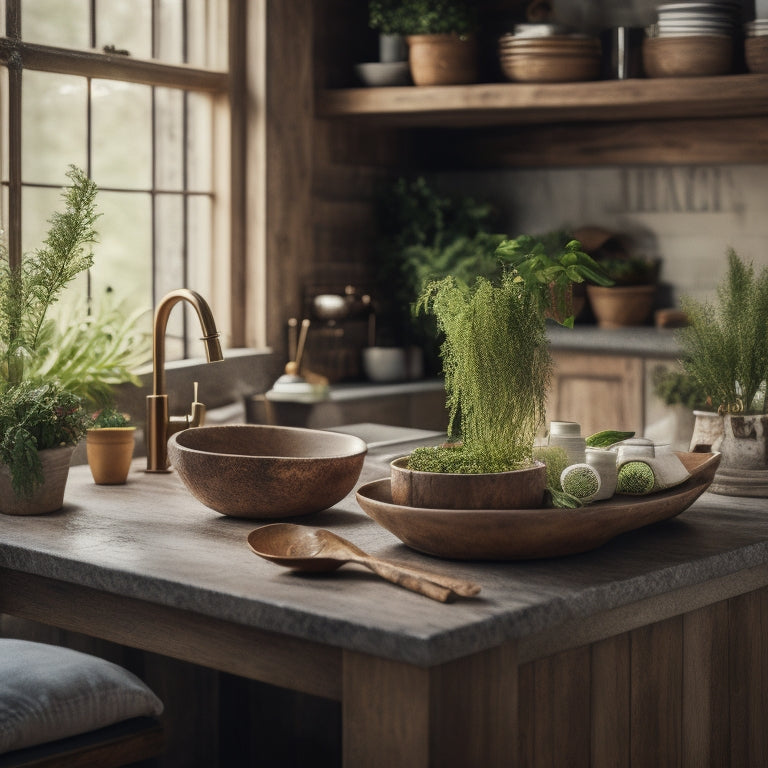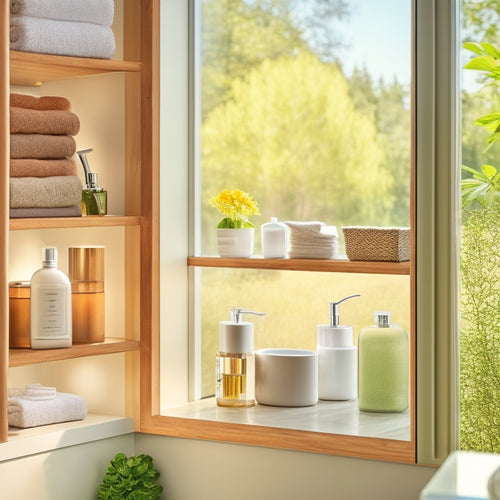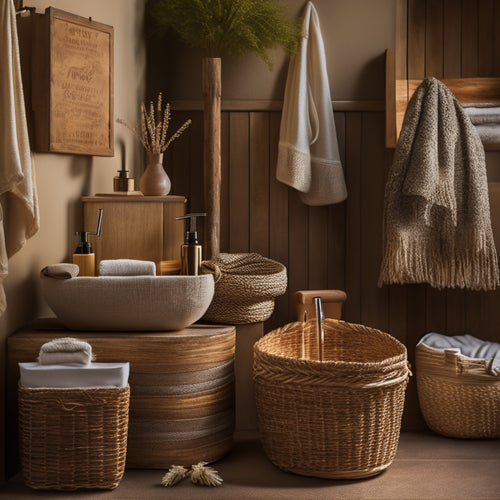
What to Know About Wood Sinks
Share
When considering wood sinks, you're likely drawn to their eco-friendly appeal and unique character. But before making a decision, it's crucial to comprehend the construction process, which involves selecting the right wood type and applying waterproof sealants to guarantee durability. You'll also want to investigate the various types of wood sinks, from modern and sleek to rustic and distressed, to find the perfect fit for your kitchen style. With proper maintenance, including daily cleaning and regular sealing, a wood sink can last for decades. As you weigh the pros and cons, there's more to uncover about this sustainable option.
Key Takeaways
- Wood sinks are an eco-friendly choice, made from sustainable materials like reclaimed wood, bamboo, and hardwoods, adding warmth to kitchen spaces.
- Proper construction involves selecting durable wood types, using mortise and tenon or dovetail joints, and applying waterproof sealants for moisture protection.
- Daily cleaning, regular application of protective coatings, and controlling humidity are essential for maintaining a wood sink and preventing water damage and cracks.
- Wood sinks can be prone to cracks and water damage if not properly maintained, and softer woods are more susceptible to noticeable cracks and fissures.
- Budgeting for a wood sink should consider the cost of materials, installation, and plumbing modifications, with prices ranging from $1,000 to over $5,000.
Wood Sinks: A Sustainable Option
Your kitchen renovation project presents a unique opportunity to make an eco-friendly statement with wood sinks, a sustainable option that's gaining popularity among environmentally conscious homeowners.
By choosing wood sinks, you're not only reducing your carbon footprint but also adding a touch of warmth and character to your kitchen. Eco-friendly materials like reclaimed wood, bamboo, and sustainably harvested hardwoods are being used to craft these sinks, making them an attractive option for those looking to reduce their environmental impact.
Wood sinks also offer a unique design aesthetic that can enhance your kitchen's style. From modern and sleek to rustic and traditional, wood sinks can be customized to fit your design vision.
The natural beauty of the wood grain adds a level of sophistication and warmth that's hard to achieve with traditional sink materials. Plus, with proper maintenance, wood sinks can last for decades, making them a durable and long-lasting option for your kitchen renovation.
Understanding Wood Sink Construction
As you consider wood sinks for your kitchen renovation, it's important to understand the construction process that goes into creating these unique fixtures.
You're not just buying a sink, you're investing in a piece of craftsmanship. The process begins with selecting the right wood type, which can range from durable hardwoods like walnut or maple to resilient softwoods like cedar or cypress.
The chosen wood is then carefully cut, shaped, and assembled using various construction techniques, such as mortise and tenon or dovetail joints, to create the sink's basin and apron.
The wood is then treated with a waterproof sealant to protect it from moisture and guarantee durability.
Some manufacturers may also add additional features, like copper or stainless steel inserts, to enhance the sink's functionality.
The attention to detail and skill required to craft a wood sink are what set it apart from its mass-produced counterparts.
Popular Types of Wood Sinks
From rustic to modern, wood sinks come in a variety of styles and types to suit different tastes and kitchen decors.
You'll find that each type of wood sink has its own unique characteristics, advantages, and disadvantages. Oak wood sinks, for instance, are known for their durability and resistance to warping, making them a great choice for busy kitchens. Walnut wood sinks, on the other hand, offer a rich, dark color and a fine grain that adds a touch of sophistication to any kitchen.
When it comes to style, you'll need to decide between modern and rustic. Modern wood sinks feature clean lines, minimal ornamentation, and a sleek finish. Rustic wood sinks, by contrast, boast a more distressed look, with visible grain patterns and a warm, earthy tone.
If you're looking for a statement piece, a rustic wood sink might be the way to go. But if you prefer a more understated look, a modern wood sink could be the better fit.
Ultimately, the type of wood sink you choose will depend on your personal style, kitchen decor, and functional needs.
Wood Sink Maintenance Essentials
You'll need to establish a daily cleaning routine to prevent dirt and grime from building up on your wood sink's surface.
Additionally, you'll want to apply wood finishing touches periodically to maintain the sink's natural beauty and protect it from wear.
Daily Cleaning Routine
Maintaining your wood sink's natural beauty and durability requires a consistent daily cleaning routine.
You'll want to wipe down your sink after every use to prevent water spots and stains. Use a soft, dry cloth to remove any food particles and debris.
For more thorough cleaning, mix a solution of mild dish soap and warm water, and apply it to the sink using a soft-bristled brush.
Be sure to avoid using harsh cleaning products, abrasive sponges, or bleach, as these can damage the wood finish. Instead, opt for gentle cleaning products specifically designed for wood surfaces.
Rinse the sink thoroughly with warm water, and dry it with a clean towel to prevent water spots.
By incorporating this daily cleaning routine into your sink maintenance, you'll be able to enjoy your wood sink's natural beauty for years to come.
Wood Finishing Touches
As you've established a daily cleaning routine, it's time to focus on wood finishing touches that will enhance your sink's appearance and protect its wood surface.
Now, it's all about perfecting the art of finishing techniques to bring out the beauty of your wood sink. You'll want to apply a protective coating to shield your sink from water spots, scratches, and daily wear and tear.
Look for water-resistant finishes like polyurethane, tung oil, or beeswax, which will create an impenetrable barrier against moisture. When applying the finish, make sure to follow the manufacturer's instructions and use a clean, lint-free cloth to avoid leaving streaks or marks.
Regularly reapplying a finish every 6-12 months will maintain your sink's luster and prevent damage. Additionally, consider using a wood conditioner to keep your sink's wood hydrated and supple.
Moisture Damage Prevention
Prevent water from seeping into your wood sink's pores by sealing any gaps or cracks around the faucet, drain, and countertops.
You'll want to get a good sealant that's specifically designed for wood sinks, as they can withstand the constant moisture and humidity. Look for sealant options that are waterproof, mold-resistant, and non-toxic – you don't want any harsh chemicals leaching into your water or food.
Next, focus on humidity control. Wood sinks thrive in environments with moderate humidity levels, between 40-60%.
If your kitchen is prone to dryness or excessive moisture, consider investing in a humidistat to regulate the air. This will prevent your sink from shrinking or expanding excessively, reducing the risk of cracks and damage.
Regularly inspect your sink for signs of water damage, such as warping, discoloration, or soft spots.
If you notice any issues, address them promptly to prevent further damage. By staying on top of moisture damage prevention, you'll enjoy a beautiful, functional wood sink for years to come.
Common Wood Sink Problems
As you install and use your wood sink, you'll likely encounter common issues that can affect its performance and longevity.
Cracks and fissures can form over time, allowing water to seep in and cause damage, which can lead to costly repairs or even replacement.
Additionally, you'll find that maintaining your wood sink can be challenging due to its porous nature, requiring regular upkeep to prevent water damage and other problems.
Cracks and Fissures Form
Many wood sinks develop cracks and fissures over time, often within the first few years of use. You might notice these imperfections as tiny lines or hairline cracks that seem to appear out of nowhere.
But don't worry, it's not a defect in the sink itself - it's just a natural consequence of wood expansion and natural aging.
As the wood adjusts to changes in humidity and temperature, it expands and contracts, causing small cracks to form. This process is completely normal, and it doesn't affect the sink's functionality.
However, if you're concerned about the aesthetic appeal, you can take steps to minimize the appearance of these cracks. Regularly applying a wood conditioner or sealant can help reduce the visibility of these imperfections.
Keep in mind that some types of wood are more prone to cracking than others. For instance, softer woods like pine or fir might develop more noticeable cracks than harder woods like oak or maple.
But with proper care and maintenance, your wood sink can still look beautiful and functional for years to come.
Water Damage Occurs Easily
Wood's porous nature makes it susceptible to water damage, which can occur more easily than you might expect.
Even with a well-maintained sink, water can seep into the wood's pores, causing damage that's difficult to repair. Excessive humidity in the air can also contribute to water damage, as the wood absorbs moisture from the atmosphere. This can lead to warping, discoloration, or even rotting of the wood.
To minimize the risk of water damage, it's crucial to apply protective coatings to your wood sink. These coatings create a barrier between the wood and water, preventing damage from occurring.
However, even with coatings, you still need to be vigilant about drying your sink thoroughly after each use. Any standing water can seep beneath the coating and cause damage.
Maintenance Is Challenging
Maintaining your wood sink requires constant vigilance, as even minor lapses in care can lead to a host of problems. You'll need to stay on top of wood sink care to prevent issues like warping, cracking, and discoloration. To keep your sink in top condition, you'll need to commit to regular cleaning, drying, and oiling.
Here's a breakdown of common maintenance tasks and their frequency:
| Task | Frequency | Why It's Important |
|---|---|---|
| Clean and dry the sink | Daily | Prevents water spots and bacterial growth |
| Apply wood oil or wax | Weekly | Protects the wood from drying out and cracking |
| Inspect for scratches and cracks | Monthly | Allows for early intervention and repair |
| Refinish the sink (if needed) | Every 1-2 years | Restores the wood's protective coating and appearance |
Wood Sink Installation Considerations
When installing a wood sink, several crucial considerations come into play to guarantee a successful and long-lasting integration with your overall plumbing system.
You'll want to ascertain that your wood sink is installed correctly to avoid costly repairs, water damage, or even a complete replacement.
Here are some key installation tips to keep in mind:
-
Measure twice, install once: Take precise measurements of your sink and surrounding countertops to guarantee a seamless fit.
-
Get the right support: Wood sinks are heavier than traditional sinks, so you'll need additional support underneath to prevent warping or cracking.
-
Seal it up: Apply a waterproof sealant around the sink's edges to prevent water from seeping behind the sink and causing damage.
- Hire a pro (if needed): If you're not comfortable with DIY installations, consider hiring a professional plumber to ascertain a flawless integration with your plumbing system.
Wood Sink Cost and Budgeting
Your budget takes center stage as you steer the process of incorporating a wood sink into your kitchen or bathroom renovation. You're likely wondering, "How much is this gonna set me back?"
Well, the cost of a wood sink can vary widely, depending on factors like the type of wood, sink size, and craftsmanship.
On the high end, exotic hardwoods like walnut or teak can cost upwards of $5,000 or more for a custom-made sink. On the other hand, more budget-friendly options like reclaimed pine or fir can start around $1,000 to $2,000.
If you're looking for a cost-effective solution, consider a wood sink basin made from engineered wood, which can be a more affordable alternative to solid hardwood.
When making cost comparisons, be sure to factor in the cost of installation, as well as any necessary plumbing or countertop modifications.
Additionally, consider the long-term benefits of a wood sink, such as its potential to increase your home's value and provide a unique, eco-friendly design element.
Wood Sink Durability and Longevity
As you weigh the benefits of a wood sink, durability and longevity are likely top of mind, since a sink is a heavily used fixture in both kitchens and bathrooms.
You're probably wondering: will this sink withstand the daily abuse of dirty dishes, soap scum, and who-knows-what-else? The good news is that a well-maintained wood sink can last for decades.
Here are a few things to keep in mind when it comes to wood sink lifespan and resilience:
-
Quality of construction: A sink built with high-quality wood and craftsmanship will naturally last longer than a cheaper alternative.
-
Sealing and maintenance: Regularly sealing and maintaining your wood sink will help protect it from water damage and wear.
-
Usage and traffic: If you have a large family or entertain frequently, your sink may not last as long as one in a smaller household.
- Material selection: Certain types of wood, like teak or walnut, are naturally more resistant to water and wear than others.
Styling Your Wood Sink Space
Now that you've considered the durability and longevity of a wood sink, it's time to think about how to style the space around it. This is where you get to release your creativity and bring your design inspirations to life.
Think about the overall aesthetic you want to achieve – modern, rustic, coastal, or eclectic – and choose a color palette that complements your wood sink. Neutral tones like whites, grays, and beiges can create a clean and crisp look, while earthy tones like browns and tans can add warmth and coziness.
Consider the surrounding cabinetry, countertops, and flooring to guarantee a cohesive look. You can also add decorative elements like pendant lights, wall art, and accessories to enhance the overall ambiance.
Don't be afraid to mix and match different materials, like metal and glass, to create visual interest. Remember, your wood sink is a statement piece, so let it be the star of the show.
With a little creativity and planning, you can create a stunning space that's both functional and beautiful.
Frequently Asked Questions
Can Wood Sinks Be Used in a Kitchen With High Humidity?
You're wondering if a wood sink can survive in a kitchen with high humidity? Well, it can, but you'll need to commit to regular wood sink maintenance, as humidity effects can cause warping, cracking, and water damage if left unchecked.
Are Wood Sinks Resistant to Acidic Substances Like Citrus?
You'll want to exercise caution when squeezing that fresh OJ, as wood sinks aren't naturally resistant to acidic substances like citrus; however, with proper wood sink maintenance and care, you can minimize damage and keep your sink looking fabulous for years to come!
Can I Install a Garbage Disposal With a Wood Sink?
You're wondering if you can install a garbage disposal with your wood sink? Well, technically, yes, but be prepared for extra wood sink maintenance, as disposal juices can wreak havoc on the wood, so choose a compatible model and seal that sink like your life depends on it!
Do Wood Sinks Come in Custom Sizes and Shapes?
You'll be thrilled to know that wood sinks can be custom-made to fit your unique space, offering endless design options! Just keep in mind you'll need to balance style with maintenance tips to guarantee your sink stays gorgeous and functional.
Can Wood Sinks Be Refurbished or Refinished if Damaged?
If you damage your wood sink, don't freak out! You can refurbish or refinish it using advanced repair techniques, and with regular maintenance tips like oiling and sealing, you'll be back to washing dishes in no time, with your sink looking brand new again!
Conclusion
As you weigh the pros and cons of wood sinks, remember that they bring warmth, character, and eco-friendliness to your kitchen. Like a fine wine, they mature with time, developing a rich patina that tells a story. With proper care, they'll serve you for years, their natural beauty progressing alongside your cooking style.
Related Posts
-

Modular Storage for Bathroom Decluttering
Modular storage is your solution for effective bathroom decluttering. It maximizes every inch of space, allowing cust...
-

Rustic Bathroom Storage Baskets and Bins
Rustic bathroom storage baskets and bins add both charm and practicality to your space. Made from natural materials l...
-

RADICAL HEALTH REVOLUTION: Blueprint for Eternal Wellness
I've spent years feeling stuck, searching for a way to break free from mediocre health and access a life of vibrancy ...


